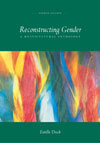 |
1 |  | 
In Reading 25 (For the White Person Who Wants to Know How to Be My Friend), author Pat Parker's main point is that friends should work hard to overcome racial differences. |
|  | A) | True |
|  | B) | False |
 |
 |
2 |  | 
In Reading 26 (You Just Don’t Understand: Women and Men in Conversation), Deborah Tannen argues that during conversation men want their troubles validated by empathetic listeners. |
|  | A) | True |
|  | B) | False |
 |
 |
3 |  | 
According to Deborah Tannen in Reading 26 (You Just Don’t Understand: Women and Men in Conversation), when women share troubles, they are often not seeking advice, but rather understanding. |
|  | A) | True |
|  | B) | False |
 |
 |
4 |  | 
In Reading 27 (Real Men Don't Cry . . . And Other "Uncool" Myths), Phil Petrie suggests that men mistakenly use sex as a means of communication. |
|  | A) | True |
|  | B) | False |
 |
 |
5 |  | 
According to Susan J. Douglas and Meredith W. Michael in Reading 28 (The Mommy Myth: The Idealization of Motherhood and How It Has Undermined Women), competition today isn’t just over who is a good mother; it is over who’s the best. |
|  | A) | True |
|  | B) | False |
 |
 |
6 |  | 
According to Ayana Byrd in Reading 29 (Claiming Jezebel: Black Female Subjectivity and Sexual Expression in Hip-Hop), in 1980, outside of academic conferences, few observers pointed out that the majority of women in the United States on welfare were white, and that most women stayed on public assistance for two years or less. |
|  | A) | True |
|  | B) | False |
 |
 |
7 |  | 
In Reading 29 (Claiming Jezebel: Black Female Subjectivity and Sexual Expression in Hip-Hop), Ayana Byrd states that during the whole of the nineteenth century, depictions of white female bodies were often sexualized in ways that black women’s never were. |
|  | A) | True |
|  | B) | False |
 |
 |
8 |  | 
In Reading 30 (The New Girls Network: Women, Technology, and Feminism), Shireen Lee states that she left a job in technology because there was no gender awareness or sensitivity there. |
|  | A) | True |
|  | B) | False |
 |
 |
9 |  | 
According to Shireen Lee in Reading 30 (The New Girls Network: Women, Technology, and Feminism), President Bush reinstated the “global gag rule,” which allows government agencies to give funds to private family planning programs outside of the United States at their discretion. |
|  | A) | True |
|  | B) | False |
 |
 |
10 |  | 
According to Laura Zimmerman in Reading 31 (Where are the women? The strange case of the missing feminists. When was the last time you saw one on TV?). When was the last time you saw one on TV?), Jill Nelson lost a great amount of freelance work at September 11th due to a “post 9/11 paradigm shift.” |
|  | A) | True |
|  | B) | False |
 |
 |
11 |  | 
In Reading 31 (Where are the women? The strange case of the missing feminists. When was the last time you saw one on TV?), Laura Zimmerman states that a 2002 Fairness and Accuracy in Reporting [FAIR] study showed that in 2001, U.S. sources interviewed on the three major networks were mostly non-white and male. |
|  | A) | True |
|  | B) | False |
 |
 |
12 |  | 
In Reading 25 (For the White Person Who Wants to Know How to Be My Friend), author Pat Parker expects her friends to: |
|  | A) | like Aretha Franklin |
|  | B) | apologize for their racism |
|  | C) | allow her to educate them about Black culture |
|  | D) | all of the above |
 |
 |
13 |  | 
In Reading 27 (Real Men Don't Cry . . . And Other "Uncool" Myths), Phil Petrie argues that he cannot fully communicate all of his feelings because: |
|  | A) | he is being asked to pattern his communication after a white man |
|  | B) | he does not know how to communicate his feelings |
|  | C) | it is a loss of power to do so |
|  | D) | he is fearful of femininity |
 |
 |
14 |  | 
According to Susan J. Douglas and Meredith W. Michael in Reading 28 (The Mommy Myth: The Idealization of Motherhood and How It Has Undermined Women), beginning in the mid-1970’s, working mothers became the most important thing you can become in the United States: a __________. |
|  | A) | trend |
|  | B) | union |
|  | C) | market |
|  | D) | society |
 |



 2006 McGraw-Hill Higher Education
2006 McGraw-Hill Higher Education